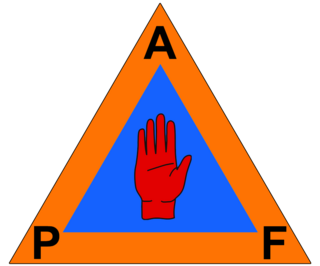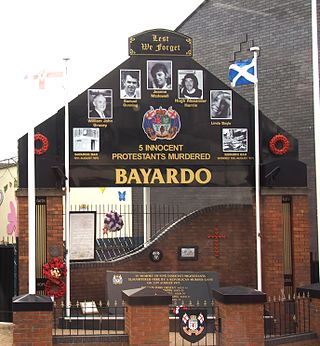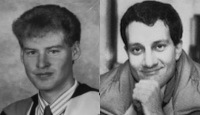
The Irish People's Liberation Organisation was a small Irish socialist republican paramilitary organisation formed in 1986 by disaffected and expelled members of the Irish National Liberation Army (INLA), whose factions coalesced in the aftermath of the supergrass trials. It developed a reputation for intra-republican and sectarian violence as well as criminality, before being forcibly disbanded by the Provisional Irish Republican Army (IRA) in 1992.

The Milltown Cemetery attack took place on 16 March 1988 at Milltown Cemetery in Belfast, Northern Ireland. During the large funeral of three Provisional IRA members killed in Gibraltar, an Ulster Defence Association (UDA) member, Michael Stone, attacked the mourners with hand grenades and pistols. He had learned there would be no police or armed IRA members at the cemetery. As Stone then ran towards the nearby motorway, a large crowd chased him and he continued shooting and throwing grenades. Some of the crowd caught Stone and beat him, but he was rescued by the police and arrested. Three people were killed and more than 60 wounded.

Royal Air Force Station Wildenrath, commonly known as RAF Wildenrath, was a Royal Air Force (RAF) military airbase near Wildenrath in North Rhine-Westphalia, Germany, that operated from 1952 to 1992. Wildenrath was the first of four 'clutch' stations built for the Royal Air Force in Germany during the early 1950s.

On 19 March 1988, the British Army corporals Derek Wood and David Howes were killed by the Provisional IRA in Belfast, Northern Ireland, in what became known as the corporals killings.
This is a chronology of activities by the Provisional Irish Republican Army (IRA) from 1970 to 1979.

Desmond "Dessie" Grew was a volunteer in the East Tyrone Brigade of the Provisional Irish Republican Army (IRA). Grew was killed by undercover Special Air Service soldiers in County Armagh in 1990 along with fellow IRA volunteer, Martin McCaughey who was also a Sinn Féin councillor.

The Protestant Action Force (PAF) was a front group used by Ulster loyalist paramilitaries in Northern Ireland when claiming responsibility for a number of attacks during the Troubles. First used in 1974, attacks by individuals claiming to be members of the PAF killed at least 41 Catholic civilians. The PAF was most commonly used by members of the Ulster Volunteer Force (UVF). All of the attacks claimed by the PAF in Armagh and Tyrone counties from 1974 to 1976 have been linked to the Glenanne gang, which was a group consisting of members of the UVF Mid-Ulster Brigade along with rogue Ulster Defence Regiment (UDR) soldiers and Royal Ulster Constabulary (RUC) police officers. A six-year period of no attacks claimed by the PAF ended in 1982; during the 1980s, the PAF claimed 15 attacks in the Belfast area and two in County Armagh. UDR soldiers were convicted of two attacks in Armagh. The PAF claimed its last attacks in the early 1990s, all of which were in north Armagh and were alleged to involve members of the security forces.
Donna Maguire is a former volunteer in the Provisional Irish Republican Army (IRA) once described as Europe's most dangerous woman.
This is a chronology of activities by the Provisional Irish Republican Army (IRA) from 1980 to 1989. For actions before and after this period see Chronology of Provisional Irish Republican Army actions.

The Bayardo Bar attack took place on 13 August 1975 in Belfast, Northern Ireland. A unit of the Provisional Irish Republican Army (IRA), led by Brendan McFarlane, launched a bombing and shooting attack on a pub on Aberdeen Street, in the loyalist Shankill area. IRA members stated the pub was targeted because it was frequented by members of the Ulster Volunteer Force (UVF). Four Protestant civilians and one UVF member were killed, while more than fifty were injured.

The Coagh ambush was a military confrontation that took place in County Tyrone, Northern Ireland, on 3 June 1991, during The Troubles, when a Provisional Irish Republican Army (IRA) active service unit from its East Tyrone Brigade was ambushed by the British Army's Special Air Service (SAS) at the village of Coagh, in County Tyrone, whilst on its way to kill a part-time member of the Ulster Defence Regiment (UDR). The ambush resulted in the deaths of all three IRA men involved.

On 15 June 1988 an unmarked military van carrying six British Army soldiers was blown up by the Provisional Irish Republican Army (IRA) at Market Place in Lisburn, Northern Ireland. The explosion took place at the end of a charity marathon run in which the soldiers had participated. All six soldiers were killed in the attack – four outright, one on his way to hospital and another later on in hospital.
Heidi Hazell was a German citizen murdered by the Provisional Irish Republican Army (IRA.) The investigation into her murder was reopened in March 2015. The victim's family and the German Federal Attorney have argued that the Good Friday Agreement, which imposes limitations on retrospective criminal proceedings being filed against paramilitaries who committed crimes during The Troubles, may not be binding. This argument is made on the basis that the Geneva Convention would supersede the Good Friday Agreement in a situation where a civilian non-combatant like Hazell was killed by a paramilitary, thereby demanding prosecution as a war crime. The murder of Hazell, a German citizen, also took place in Germany and the country is not legally bound by the agreement between the United Kingdom and Ireland.
The 1987 Rheindahlen bombing was a car bomb attack on 23 March 1987 at JHQ Rheindahlen military barracks, the British Army headquarters in West Germany, injuring thirty-one. The large 300 lb (140 kg) car bomb exploded near the visitors officers' mess of the barracks. The Provisional IRA later stated it had carried out the bombing. It was the second bombing in Rheindahlen, the first being in 1973, and the start of the IRA's campaign on mainland Europe from the late 1980s to the early 1990s. Although British soldiers were targeted, most of the injured were actually German officers and their wives.
The Provisional IRA carried out two separate attacks on the same day on 1 May 1988 against British military personnel in the Netherlands which resulted in the deaths of three RAF members and another three being injured. It was the worst attack suffered by the British security forces during The Troubles from 1969 to 1998 in mainland Europe.

The Lichfield gun attack was an ambush carried out by the Provisional IRA (IRA) on 1 June 1990 against three off-duty British soldiers who were waiting at Lichfield City railway station in Staffordshire. The attack resulted in one soldier being killed and two others badly wounded.
The Glamorgan barracks bombing was the bombing of a British Army military barracks in Duisburg, West Germany, carried out by the Provisional Irish Republican Army (IRA). The attack injured nine soldiers. The Glamorgan barracks housed soldiers from the Royal Corps of Transport. Seventy soldiers were sleeping at the time of the explosion. The two 20 lb (9 kg) bombs blew a hole in the barracks and tore the roof. Nine British soldiers received minor wounds. It was the first IRA attack on the European mainland since the Netherlands attacks in May. The two bombs were placed some eight yards inside the barracks compound, against the wall of the quarters were some 70 soldiers were sleeping. None of the nine injured soldiers needed hospital treatment, although an army sergeant spokesman said they were very lucky nobody was killed. Moments after the blast police saw the IRA getaway car run a red lightand gave chase, but the IRA unit fired shots at the police car and the police gave up the chase, letting the IRA volunteers escape.
This is a chronology of activities by the Provisional Irish Republican Army (IRA), in 1990 and 1991.
The Stag Inn attack was a sectarian gun attack, on 30 July 1976, carried out by a group of Belfast IRA Volunteers using the cover name Republican Action Force. Four Protestants, all civilians, the youngest being 48 years old and the eldest 70, were all killed in the attack with several others being injured. Three Catholics were killed the previous day in a Loyalish bomb, part of a string of sectarian attacks in Northern Ireland by different paramilitary organizations.










